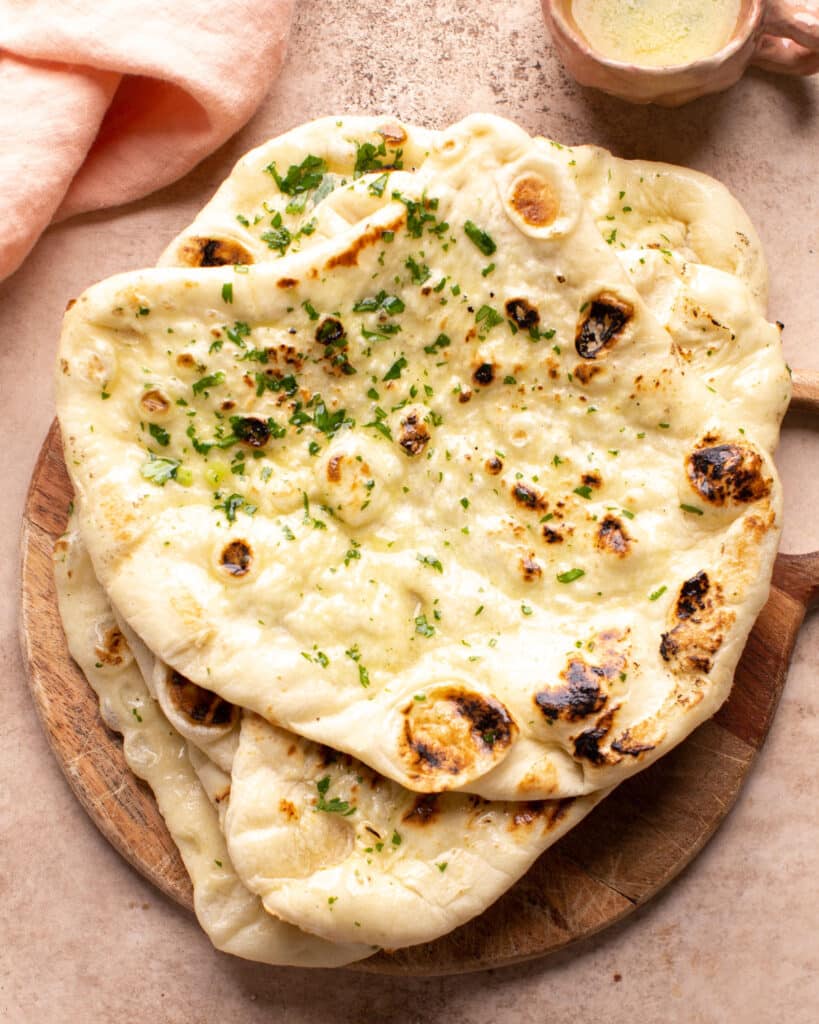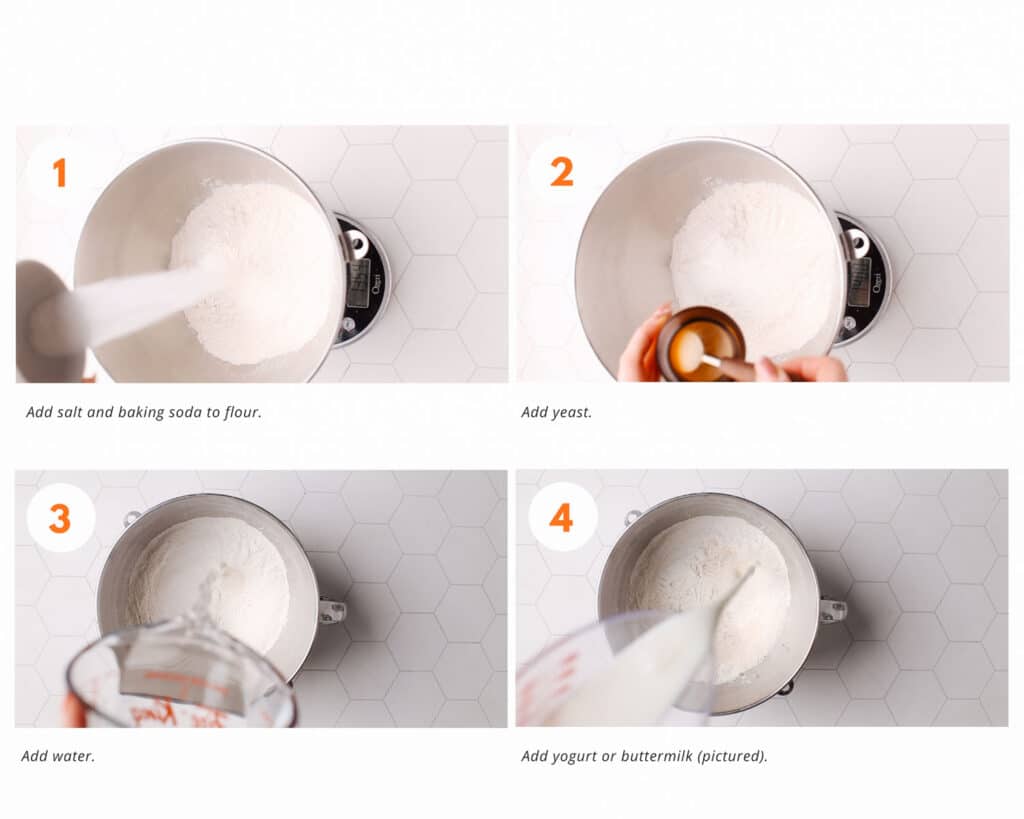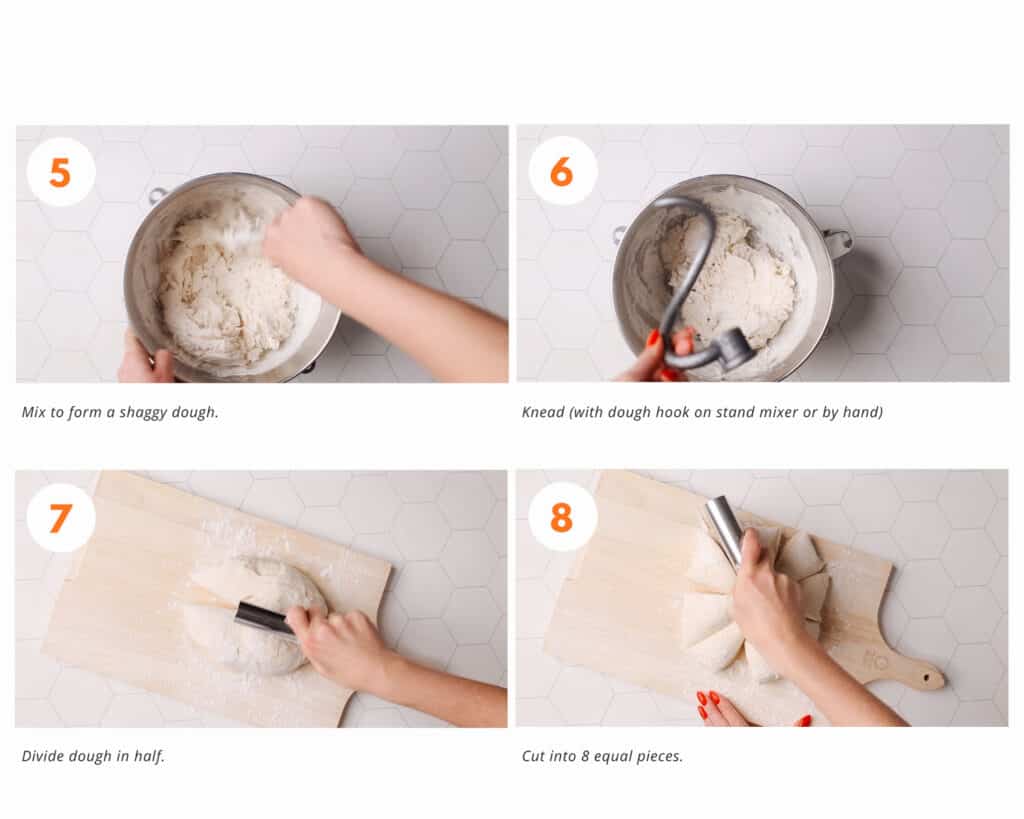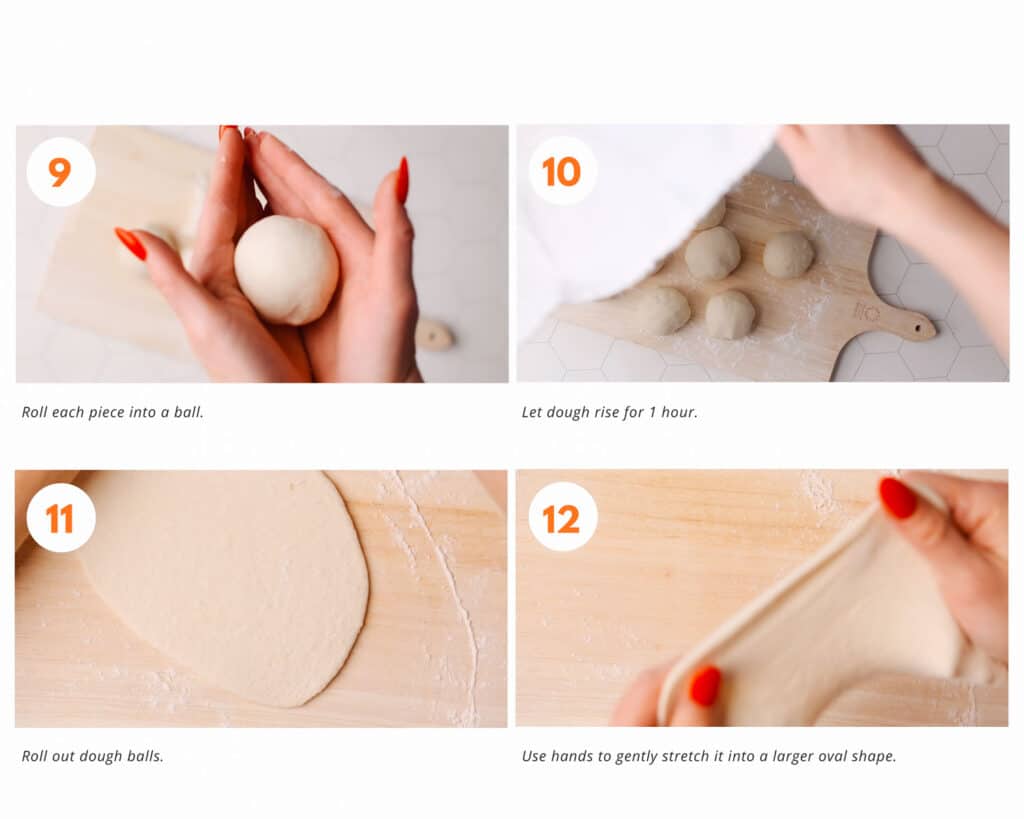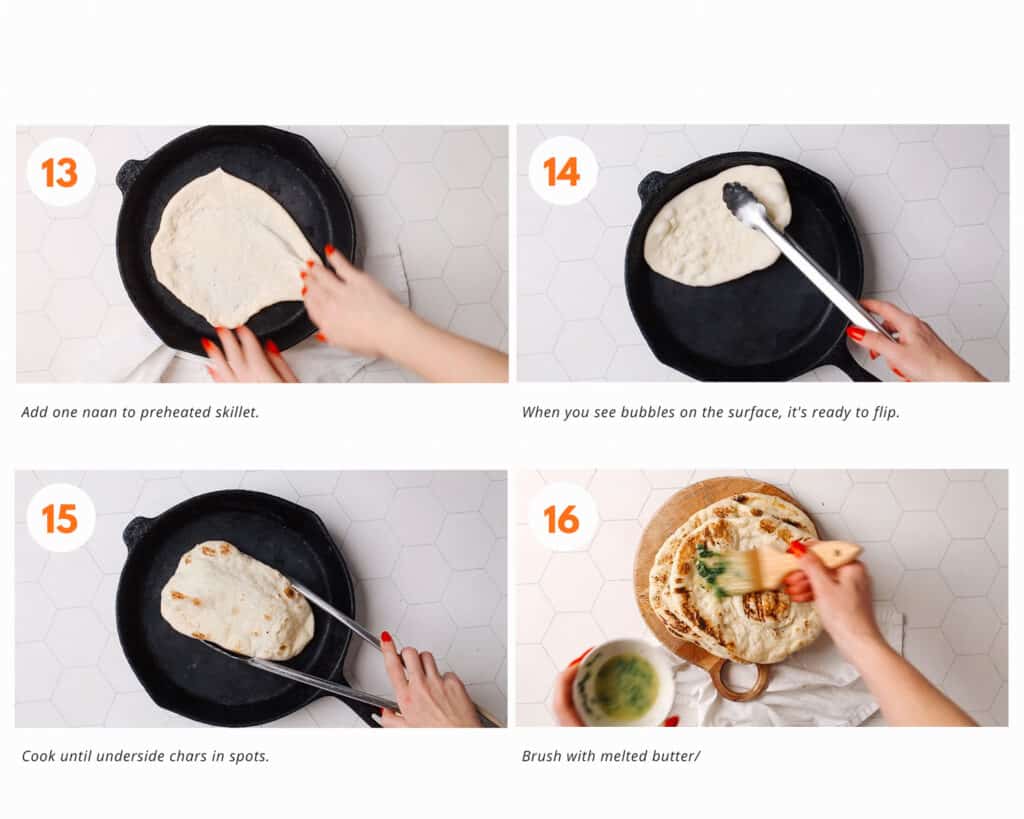Feb 06, 2023, Updated Sep 11, 2024
Butter Naan: why you’re going to fall in LOVE with this recipe
Let me just say that I’ve been in a relationship with an Indian man for almost 20 years and I’ve spent most of those years trying to make perfect naan. You can trust that this is an extensively-tested recipe that passes the authentic test.
Butter naan is traditional Indian Naan bread brushed with melted butter after cooking. You can add some minced cilantro (coriander) leaves or minced garlic to make garlic butter naan. It is a yeasted dough rolled into flatbreads and cooked traditionally in tandoor clay. My workaround makes it super easy to create that tandoori flavor and look in a cast iron skillet on the stovetop. The combination of yeast and yogurt give this recipe a complex, delicious bread flavor similar to sourdough naan without needing a sourdough starter. It puffs up on the pan (or tawa, in India) and those charred spots are irresistible. For an even more dramatic puffing up, see my notes in the recipe for finishing the naan over a direct flame (only works if you have a gas stove).
I guarantee you this easy tandoori-style naan rivals your favorite Indian restaurant. Serve it with one of these tasty Indian recipes. If you love Indian breads, you’ve gotta try my super-soft roti, paratha recipe (layered, flaky South Indian flatbread) and soft chapati recipe, too.
What is Butter Naan Made of?
Plain white flour (a.k.a. maida in India) Instant dry yeast (a.k.a. quick rise yeast): You can swap in another kind of yeast, but traditional (active dry yeast) will have to be activated first in the warm water before adding it to the dry ingredients. I love how easy it is to use instant yeast because you add it right to the flour. Baking soda: this is not always found in traditional recipe but using baking soda helps ensure lots of bubbles in the naan. Adding it decreases the acidity of the dough, which helps the dough to brown in the pan. More browning makes for more flavor and more attractive color. Baking powder doesn’t do the same for browning and flavor, but a teaspoon and a half can be used as a substitute for the baking soda and you’ll still get the extra bubbles. Baking powder: baking soda starts to work as soon as it’s combined with acidic ingredients (yogurt) and loses its leavening power as the dough sits. Baking powder is double acting – meaning it has an initial reaction when it combines with liquid, and a second reaction when heat is added. Basically, it adds extra bubble insurance! Plain yogurt: (a.k.a curd in India) don’t useextra high-fat or greek yogurt. Regular whole milk (3.25%) or 2% yogurt is perfect. Extra fat and thickness will make the dough too rich and prevent it naan from puffing up. It will have a thicker, doughier texture. I regularly use buttermilk as a substitute because I don’t always stock plain yogurt. Both work perfectly. Melted butter: this puts the butter in butter naan. It’s simply brushed onto the warm naan breads after they’re done cooking and after they’ve been transferred to a plate. Salted butter is the tastiest option. Minced cilantro: totally optional but I love the pop of green color. You could add a couple of minced fresh garlic cloves to the melted butter, too, or instead, if you like.
Notes and Tips for Amazing Butter Naan
I boil a kettle and add a ½ cup hot water to a measuring cup then add cold water to it and check the temp to make sure I won’t kill the yeast. 120°–130°F is the ideal water temperature for quick (rapid rise) yeast according to Fleischmann’s yeast website. The dough is supposed to be quite sticky after kneading. Wet your hands with water to handle it, generously flour the work surface, and oil the dough balls on top and bottom before letting them rise. If the dough is too sticky to handle, gently knead more flour into it. Be sure to let it rest for 1 hour if you work the dough. The 1 hour rise time is not only important for the dough to get bubbly, it is super important to making the naan soft. As you knead the dough (or have the mixer do it for you with a dough hook), you create a super tight, bouncy dough. If not rested, the dough will shrink up after rolling it out and you’ll have hard, small flatbreads instead of lovely tender ones. If you have a gas stove, you can make finish the naan over a direct flame to make it even more like authentic tandoori naan. When you flip the naan over, cook the underside for just long enough to seal the surface so it isn’t sticky. Carefully use tongs to move the naan over to a direct flame. The naan will puff dramatically and yummy charred spots will appear. Just watch closely.
How to Make Naan Dough in Advance
You can prepare the dough in advance and keep it in the refrigerator or the freezer. Either way, I prefer to store the dough as balls rather than as one giant bowl of dough in the bowl of a stand mixer because then you have to work the dough less just before cooking (working the dough less results in softer naan). To Refrigerate:
Prep the recipe up to forming the dough balls. Arrange the dough balls on a parchment-paper-lined plate, drizzle with a bit of oil and turn the dough around to coat them fully (this prevents them from sticking as well as preventing the surface from drying out). Then cover with plastic wrap or pack into an airtight container and refrigerate for up to 4 days. You can skip the 1-hour rise as they’ll slowly rise in the fridge for the same result. Before rolling the dough into large ovals, let it warm back up to room temperature.
NOTE: I don’t recommend rolling it out in advance and storing the fully-shaped raw dough. As a sticky mixture, it can be hard to lift flattened dough off of the parchment paper and it would be frustrating to lose your hard work in shaping. To Freeze:
Again, make the recipe up to forming the dough balls. Line a baking sheet or plate with parchment paper, drizzle with a bit of oil and turn the dough around to coat the dough fully. Skip the 1-hour rise and freeze uncovered in a single layer until solid. Transfer frozen dough to a freezer bag or airtight container. Thawing: Thaw frozen dough balls in the refrigerator overnight or at room temperature for a few hours before use. To prevent sticking to the container or bag, transfer them back to an oiled sheet of parchment paper and cover loosely with another sheet or parchment before covering with a clean towel or plastic wrap. You can keep dough frozen for up to 3 months.
How to Store Cooked Naan
Store leftover naan in an airtight container or zipper bag at room temperature for up to 1 day. Do not store cooked naan in the fridge. Refrigerating cooked naan will make it hard. The temperature of the fridge speeds up the staling process in baked goods. If you won’t use up leftovers within 1 day, just freeze it.
To freeze cooked naan, let it cool and then pack into an airtight container separated with layers of parchment or wax paper. Freeze up to 3 months.
How to Reheat Naan
One at a time: Reheat naan one at a time in a pan or over a direct stove flame using tongs. You can even cut in half and reheat for 20 seconds in a toaster. In bulk: Wrap naan in foil to retain moisture and bake at 350ºF for about 10 minutes or until warm.
The Best Butter Chicken (Truly the best) Butter Paneer (The vegetarian version) Chicken Korma (My Indian husband Adarsh says this is the best curry I’ve ever made) Malai Kofta (Fluffy potato dumplings in creamy curry) Aloo Gobi (Indian cauliflower and potato curry) South Indian Pork Curry (The spicy coconut curry is so tasty) Saag Paneer (Spinach and Paneer Curry) Lamb Vindaloo (Fall-apart tender lamb in flavorful spicy coconut sauce) Chicken 65 (Adarsh’s own concoction, and a delicious fan favorite)
Win your friends and family over by serving up some crispy, golden homemade chicken samosas on the side. If you have leftover naan, whip up a batch of this 5-minute Indian Chickpea Salad for lunch, you’ll love it. And when it’s all gone, try my soft and fluffy Turkish Bread next!
